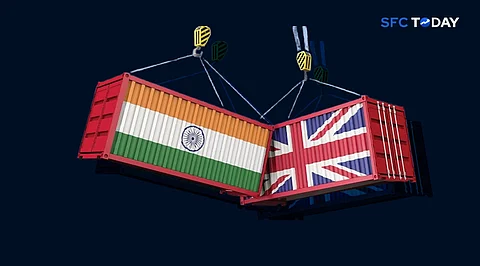

On July 24, 2025, India and the United Kingdom signed a historic Free Trade Agreement (FTA) in London. This agreement is expected to significantly change how the two countries do business with each other. It covers a wide range of areas, including trade in goods and services, digital trade, investment, government procurement, and intellectual property. The deal is being seen as a major move that could strongly increase bilateral trade in the coming years.
The FTA aims to boost trade between India and the UK to over £25 billion per year by 2040. According to India’s Export Promotion Council, this agreement could even help double total trade to around $120 billion by 2030, from the current level of around $60 billion.
Trade experts believe that the agreement could help trade grow at an average rate of 15% per year. For the UK, this deal could add about £4.8 billion to its economy every year, and exports are expected to increase by nearly £15 billion by 2040.
The trade deal benefits multiple industries in both countries. Here are some of the major sectors that stand to gain:
Indian textile and garment exporters currently face duties of 8–12% in the UK. With this agreement, these duties will be removed. This will make Indian products cheaper and more attractive in the UK market. As a result, exports from cities like Tiruppur, Surat, and Ludhiana are expected to grow by 30% to 45%, creating thousands of new jobs—especially for women.
The agreement is expected to help India increase its jewellery exports to the UK to about $2.5 billion in the next two years. Indian gems and jewellery are already popular in the UK, and reduced tariffs will further boost their demand.
Other sectors expected to benefit include leather products, pharmaceuticals, and engineering goods. With reduced tariffs and easier regulations, Indian pharmaceutical companies will find it simpler to sell their products in the UK.
India currently imposes very high tariffs (150%) on imported whisky. Under the new deal, these tariffs will be gradually reduced to 40% over ten years. This will make whisky from the UK much cheaper in India. It is expected that Scotch whisky exports alone could increase by £1 billion in five years.
India has agreed to reduce tariffs on cars and electric vehicles from over 100% to around 10%, although this will be within a certain quota. This opens up the Indian market to UK carmakers and will also encourage the use of electric vehicles in India.
The deal also focuses on services and skilled professionals. Around 1,800 additional work visas will be given to Indian professionals every year. Also, professional qualifications (like for doctors, engineers, and accountants) will be recognized in both countries, making it easier for professionals to work abroad.
UK companies will be able to take part in public projects in India, particularly in non-sensitive areas. This will open up opportunities in a government procurement market worth billions. The deal also includes important provisions related to digital trade, anti-corruption, labor rights, and environmental protections.
This trade deal is very important for the UK, especially after it left the European Union (Brexit). It is the largest trade agreement signed by the UK since Brexit, and shows that the UK is serious about building new global relationships.
For India, this is its first major free trade agreement with a European country. It shows India’s willingness to open up its economy and play a bigger role in global trade. The deal also sends a strong message to the world at a time when many countries are turning inward and increasing tariffs.
While the trade agreement offers many benefits, there are also some challenges:
From 2027, European countries may impose a carbon tax on certain goods like steel, aluminium, and fertilizer. This could hurt Indian exports, even if tariffs are removed.
Although trade terms have been agreed upon, a treaty for protecting investments between the two countries is still pending. This may discourage companies from making long-term investments.
Many small and medium-sized Indian businesses may not understand how to benefit from the agreement. They may struggle to meet complex rules, such as rules of origin and technical standards.
Some areas, like agriculture and financial services, have not been fully addressed in the deal. These will need to be discussed further in the future.
The deal has been signed, but it still needs to be formally approved by the UK Parliament, which may take a few more months. In India, the Cabinet has already approved the agreement. Once both countries ratify it, the deal will come into force.
Some tariff cuts and policy changes will happen immediately, while others will be rolled out gradually over the next 10 years. Both countries also plan to deepen cooperation in areas like defence, climate change, and technology as part of a broader India–UK Vision 2035.
The India–UK Free Trade Agreement is a bold and forward-looking step. It has the power to transform the trade relationship between two major economies. By reducing tariffs, simplifying regulations, and improving access to markets, it creates fresh opportunities for businesses in both countries.
If implemented well, the deal could double trade, boost investment, and create thousands of new jobs. However, to fully realize its benefits, both governments must ensure that small businesses are informed and supported, and that remaining challenges—like investment rules and environmental standards—are addressed in the future.
This agreement sets a strong example for how countries can work together in a complex global economy, aiming for growth, fairness, and shared progress.